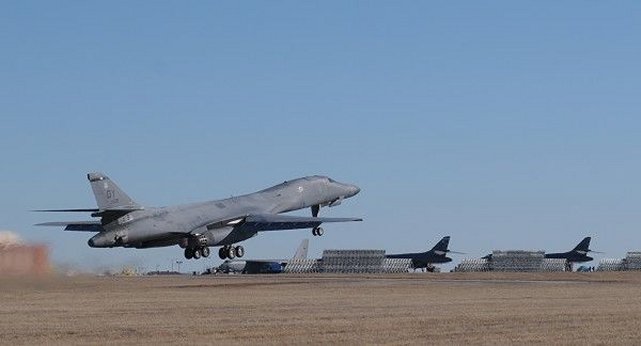Breaking news
Boeing to bring USAF B-1B Lancer bombers into the digital age with new upgrades 0505152.
| a | |||
| |
|||
World
Aviation Defense & Security Industry News - Boeing |
|||
| Boeing to bring USAF B-1B Lancer bombers into the digital age with new upgrades | |||
Boeing
has recently announced three new upgrades for U.S. Air Force B-1B Lancer
strategic bomber aircraft that bring the aircraft into the digital age.
The latest upgrade, a trio of updates known as the integrated battle station,
are ensuring the B-1 meets today’s mission requirements and further
establishes a solid foundation for additional modernization in the decades
to come.
|
|||
 First USAF B-1B Lancer strategic bomber equipped with Boeing IBS upgrade takes off from Tinker Air Force Base (Boeing) |
|||
The integrated battle
station upgrade, the most extensive modification program in B-1 history,
is a combination of three different upgrades, which include a Fully
Integrated Data Link, a Vertical Situation Display Upgrade and a Central
Integrated System Upgrade. The FIDL is a modern data link communication network that allows real-time communication with many other aircraft, ground stations and allied forces. The VSDU replaced the older VSDs with more reliable equipment that show more information faster and with more options to improve in-flight efficiency. The CITS modernized the old Light Emitting Diode display computers that are used by flight and ground support personnel to identify and troubleshoot B-1 system anomalies. "Integration into the data link environment and the increased maintainability, as well as the new computers and displays are capable of showing a better picture of the battlespace with more advanced graphics will enable the B-1 to be a force for decades to come," said on January 2015 Maj. Michael Jungquist, 337th Test and Evaluation Squadron software Block 16 project officer. These new upgrades to the B-1B will also allow the aircraft to work more effectively with other joint and coalition forces. "Real-time communication networks will allow for immediate mission planning and much quicker in-flight target changes. As the threat changes, so can the coordination with allied forces, which enables the B-1 to reach and target the new strike location," said on January 2015 Master Sgt. Eric Dassinger, 7th Maintenance Group wing avionics manager. "The Link-16 network we can connect to through FIDL is already being used on many other platforms, so integration with allied forces is nearly seamless. Full battlefield communication and information exchanges will greatly improve mission planning and provide real-time mission feedback." The three upgrades that comprise the IBS will potentially eliminate at least 30 minutes per ground test -diagnostic system checks that are similar to in-flight checks, and reducing the risk of human error from having to key in each test function. “Boeing’s integrated battle station work improves the aircraft’s performance as a global strike platform,” said Dan Ruder, Boeing’s Advanced Programs Manager. “We’re installing all-digital cockpit displays and connecting the bombers to a global communications network, capabilities that allow for greater agility and situational awareness.”“The adaptability of the jet has ensured its relevance – not only from the early 1990s to today, but from today well into the future,” said Col. Jason Combs, 7th Operations Group Commander at Dyess AFB, one of two bases that house the B-1 fleet. The combat-proven bomber continues to stand out on current missions, recently deploying a record number of precision-guided bombs during a six-month deployment in the Middle East as part of Operation Inherent Resolve. “I’ve never seen the jet as capable as it is today. When I first flew the B-1 in 1997, I recall debriefing using a handheld tape recorder, whereas today you go in the cockpit and have multiple screens with digital displays. It’s amazing how far the B-1 has come,” said Col. Combs. First delivered on June 29, 1985, the U.S. Air Force B-1 fleet has continually evolved to meet the demands of a rapidly changing battlefield. It transitioned from fulfilling a nuclear mission to be a conventional bomber in the 1990s and then was modified to perform close air support missions in the past decade. “Boeing’s role in maintaining the readiness of the nation’s bomber fleet is one we take seriously – our mission is to support the safety and effectiveness of our nation’s service members. We look forward to supporting the B-1’s mission for years to come,” said Rick Greenwell, Boeing’s B-1 Program Director. |
|||



















